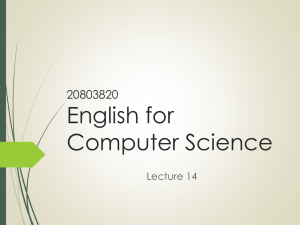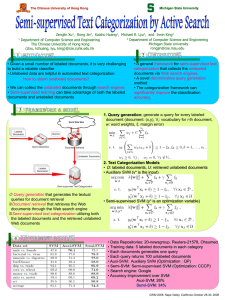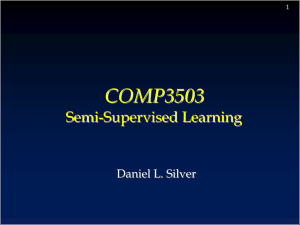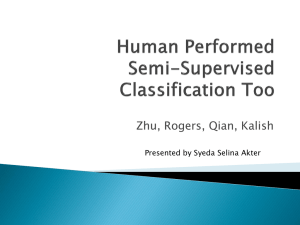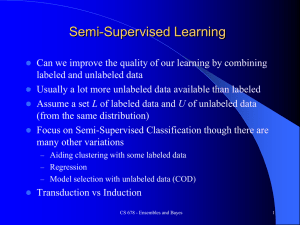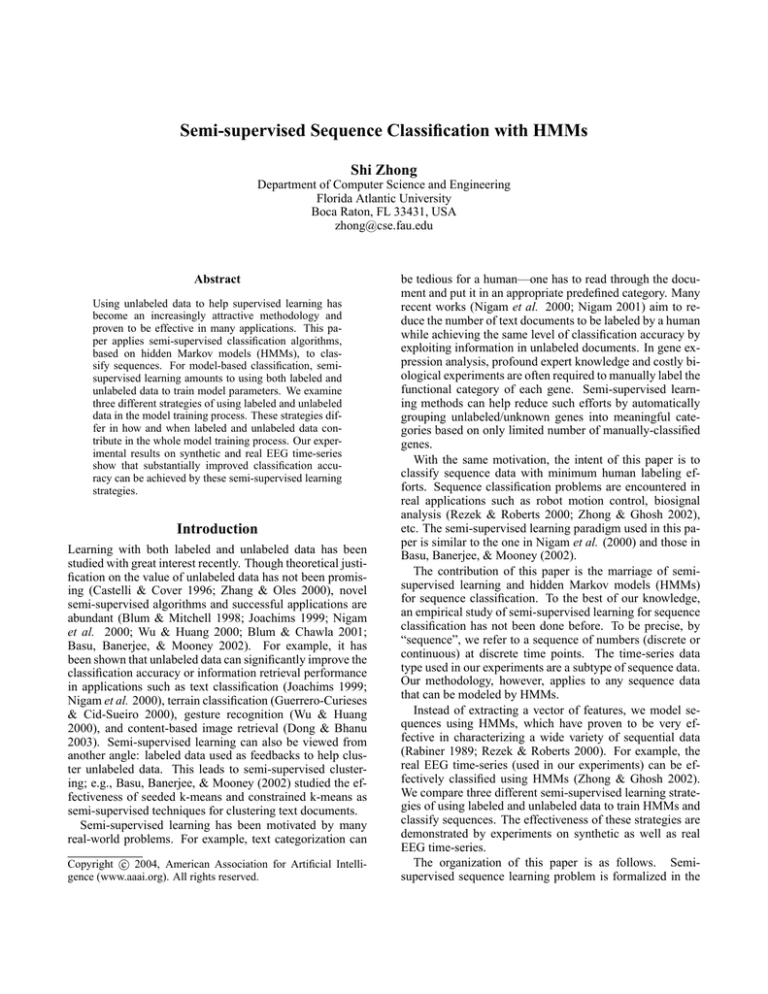
Semi-supervised Sequence Classification with HMMs
Shi Zhong
Department of Computer Science and Engineering
Florida Atlantic University
Boca Raton, FL 33431, USA
zhong@cse.fau.edu
Abstract
Using unlabeled data to help supervised learning has
become an increasingly attractive methodology and
proven to be effective in many applications. This paper applies semi-supervised classification algorithms,
based on hidden Markov models (HMMs), to classify sequences. For model-based classification, semisupervised learning amounts to using both labeled and
unlabeled data to train model parameters. We examine
three different strategies of using labeled and unlabeled
data in the model training process. These strategies differ in how and when labeled and unlabeled data contribute in the whole model training process. Our experimental results on synthetic and real EEG time-series
show that substantially improved classification accuracy can be achieved by these semi-supervised learning
strategies.
Introduction
Learning with both labeled and unlabeled data has been
studied with great interest recently. Though theoretical justification on the value of unlabeled data has not been promising (Castelli & Cover 1996; Zhang & Oles 2000), novel
semi-supervised algorithms and successful applications are
abundant (Blum & Mitchell 1998; Joachims 1999; Nigam
et al. 2000; Wu & Huang 2000; Blum & Chawla 2001;
Basu, Banerjee, & Mooney 2002). For example, it has
been shown that unlabeled data can significantly improve the
classification accuracy or information retrieval performance
in applications such as text classification (Joachims 1999;
Nigam et al. 2000), terrain classification (Guerrero-Curieses
& Cid-Sueiro 2000), gesture recognition (Wu & Huang
2000), and content-based image retrieval (Dong & Bhanu
2003). Semi-supervised learning can also be viewed from
another angle: labeled data used as feedbacks to help cluster unlabeled data. This leads to semi-supervised clustering; e.g., Basu, Banerjee, & Mooney (2002) studied the effectiveness of seeded k-means and constrained k-means as
semi-supervised techniques for clustering text documents.
Semi-supervised learning has been motivated by many
real-world problems. For example, text categorization can
c 2004, American Association for Artificial IntelliCopyright °
gence (www.aaai.org). All rights reserved.
be tedious for a human—one has to read through the document and put it in an appropriate predefined category. Many
recent works (Nigam et al. 2000; Nigam 2001) aim to reduce the number of text documents to be labeled by a human
while achieving the same level of classification accuracy by
exploiting information in unlabeled documents. In gene expression analysis, profound expert knowledge and costly biological experiments are often required to manually label the
functional category of each gene. Semi-supervised learning methods can help reduce such efforts by automatically
grouping unlabeled/unknown genes into meaningful categories based on only limited number of manually-classified
genes.
With the same motivation, the intent of this paper is to
classify sequence data with minimum human labeling efforts. Sequence classification problems are encountered in
real applications such as robot motion control, biosignal
analysis (Rezek & Roberts 2000; Zhong & Ghosh 2002),
etc. The semi-supervised learning paradigm used in this paper is similar to the one in Nigam et al. (2000) and those in
Basu, Banerjee, & Mooney (2002).
The contribution of this paper is the marriage of semisupervised learning and hidden Markov models (HMMs)
for sequence classification. To the best of our knowledge,
an empirical study of semi-supervised learning for sequence
classification has not been done before. To be precise, by
“sequence”, we refer to a sequence of numbers (discrete or
continuous) at discrete time points. The time-series data
type used in our experiments are a subtype of sequence data.
Our methodology, however, applies to any sequence data
that can be modeled by HMMs.
Instead of extracting a vector of features, we model sequences using HMMs, which have proven to be very effective in characterizing a wide variety of sequential data
(Rabiner 1989; Rezek & Roberts 2000). For example, the
real EEG time-series (used in our experiments) can be effectively classified using HMMs (Zhong & Ghosh 2002).
We compare three different semi-supervised learning strategies of using labeled and unlabeled data to train HMMs and
classify sequences. The effectiveness of these strategies are
demonstrated by experiments on synthetic as well as real
EEG time-series.
The organization of this paper is as follows. Semisupervised sequence learning problem is formalized in the
the next section, followed by an introduction to HMMs. We
then present three semi-supervised classification strategies
and show improved classification results on two time-series
datasets. Finally, we conclude this paper with remarks on
related work and future work.
Ot
Ot +1
Ot +2
St
St +1
St + 2
Ot +3
Semi-supervised Learning Problem
(l)
(l)
l
There are two types of data: labeled data L = {oi , yi }N
i=1
(u) Nu
and unlabeled data U = {oi }i=1 , where Nl is the number
of labeled data instances, Nu the number of unlabeled in(l)
l
stances, and {yi }N
i=1 the class labels of labeled sequences.
The goal is to label the unlabeled instances based on all data.
This problem is general in that we do not know whether or
not the class labels contained in labeled data is complete for
unlabeled data. It is totally legal to discover new labels from
unlabeled data, but can be very difficult. An extreme situation of the problem is the Nl = 0 case when one has to assign labels to all data. One then usually resorts to clustering
algorithms, by which “similar” data instances are grouped
together and assigned a group label. In this paper, we restrict ourselves to the scenario that labels contained in the
labeled data are complete and we aim to assign these labels
to each and every unlabeled data instance.
Our important assumption in this paper is that both labeled and unlabeled sequences are generated from the same
set of models. That is, each class of sequences is modeled
by an HMM λ and the likelihood P (o|λ) used as a measure
of how likely a sequence o is generated from the model λ.
Next we briefly describe hidden Markov models.
Hidden Markov Models
HMMs have been heavily researched and used for the past
several decades, especially in the speech recognition area
(Rabiner 1989). A standard HMM model uses a discrete hidden state at time t to summarize all the information before
t and thus the observation at any time only depends on the
current hidden state. The hidden state sequence is a Markov
chain. In this paper we use the simplest HMM, a univariate
first order HMM, in which the observation is a scalar at any
time and the state sequence is a first order Markov chain.
Such an HMM unrolled over several time slices is shown in
Fig. 1.
A standard HMM is usually
P denoted as a triplet λ =
(π, A, B). π = {πi } (where i πi = 1) is the prior probability
distribution of hidden states. A = {aij } (where
P
a
j ij = 1) is the transition probability distribution between hidden states. For discrete observation case,
P the observation distribution is B = {bj (k)} (where k bj (k) =
1). For continuous observation case, the observation distribution is usually modeled by a mixture of Gaussians
X
cjl N [o, µjl , Ujl ] ,
(1)
bj (o) =
P
l
where l cjl = 1, o is the observation vector being modeled, cjl the mixture weight, µjl the mean vector of the mth mixture, Ujl the covariance matrix of the l-th mixture for
state j and N is the Gaussian density function.
St + 3
Figure 1: A first order HMM model. The empty circles are
hidden states and the shaded ones observations.
Recently, HMMs have been extended to solve various
time-series and sequence data analysis problems, such as
protein sequence modeling (Eddy 1998) and biosignal analysis (Rezek & Roberts 2000).
Semi-supervised HMM-based Classification
(SSHC)
It is worth noting that semi-supervised model-based classification is closely related to model-based partitional clustering (Zhong & Ghosh 2003), which involves two basic
steps: (a) In a data assignment step each data instance is
assigned to one or more model(s); (b) In a model estimation step, one estimates the parameters of each model using the data instances assigned to it. In this paper, we consider “hard” assignment, where each data instance is assigned to only one model/cluster, which results in a k-means
type algorithm that has been used by many researchers (Dermatas & Kokkinakis 1996; Smyth 1997; Law & Kwok 2000;
Li & Biswas 2002).
By modifying the HMM-based k-means to accommodate
labeled sequences, we can get semi-supervised classification
algorithms. The modification basically amounts to using labeled data to initialize HMMs and/or to constrain the estimation of HMMs. The next section presents three different versions of semi-supervised HMM-based sequence classification algorithms. The first two versions can be seen
as HMM-based extensions of the constrained k-means and
seeded k-means algorithms proposed in Basu, Banerjee, &
Mooney (2002).
Semi-supervised Algorithms
The first version, we call SSHC-1, is shown in Fig. 2. It is
also the most straightforward combination of HMM-based
k-means with supervised training—first initializing HMMs
using labeled sequences and then iterating between two
steps: labeling unlabeled sequences and updating models
using both the original labeled sequences and the newlylabeled sequences. In this version, the labeled sequences
are used to constrain the whole training process of HMMs.
We call Step 1 of the SSHC-1 algorithm supervised step
and Step 2&3 semi-supervised steps. The other two versions
Algorithm: SSHC-1
Input: A set of Nl labeled sequences O
with labels Y (l)
(l)
=
(u)
(l)
=
(l)
(l)
(l)
{o1 , ..., oNl }
{y1 , ...yNl }, Nu unlabeled se(u)
quences O(u) = {o1 , ..., oNu }, HMM structure Λ =
{λ1 , λ2 , ..., λK }.
Output: Trained model parameters Λ = {λ1 , λ2 , ..., λK } and
a partition of the unlabeled sequences given by the identity
(u)
(u)
(u)
vector Y (u) = {y1 , ...yNu }, yi ∈ {1, ..., K} .
Steps:
(l)
(l)
(l)
1. Supervised training: for each class j, let Oj = {oi |yi
j}, an HMM model is trained as
X
λj = max
λ
=
log p(o|λ) ;
(l)
o∈Oj
(u)
2. Data assignment: for each unlabeled sequence oi , set
(u)
(u)
yi = arg max log p(oi |λj );
j
(u)
3. Model estimation: let Oj
(l)
(u)
(u)
= {oi |yi
= j} and Oj =
(u)
Oj ∪ Oj , the parameters of model λj is re-estimated as
P
λj = max o∈O log p(o|λ) ;
(u)
j
(u)
(u)
(u)
3. Model estimation: let Oj
= {oi |yi
= j}, using
only unlabeled sequences,
P the parameters of model λj is reestimated as λj = max o∈O(u) log p(o|λ) ;
λ
j
Figure 4: Semi-supervised HMM-based classification - 3.
We do not have enough space to give detailed analysis of time complexities for these algorithms but it can be
easily verified that the complexity for SSHC-1 and SSHC2 is O(KM M1 N T 2 ), where M is the number of semisupervised iterations, M1 the number of iterations used for
maximum likelihood estimation of an HMM model, and T
the sequence length. Note the complexity of training an
HMM is just O(M1 N T 2 ). SSHC-3 has slightly lower complexity since it uses only Nu unlabeled sequences in the
semi-supervised steps.
Experimental Study
does not change, otherwise go back to Step 2.
Figure 2: Semi-supervised HMM-based classification - 1.
of the SSHC algorithm differ from the first one in just the
semi-supervised steps. Fig. 3 shows only the Step 2&3 for
SSHC-2 algorithm, which frees labeled sequences after the
supervised step and consequently a labeled sequence may
be assigned a different label in the later semi-supervised iterative process. This is based on the idea that there may be
noise (in the labeled sequences) that may prevent the HMMs
from fitting (and classifying) unlabeled sequences better.
For SSHC-3, shown in Fig. 4 (again, only Step 2&3), we
use the trained HMMs from supervised step as a starting
point for clustering on unlabeled sequences. That is, we use
only unlabeled sequences in semi-supervised iterative process. Intuitively, this one should underperform SSHC-1 and
SSHC-2 since it uses less information (unlabeled data only)
after the supervised step. We include it here, however, for
completeness. The words in boldface in Fig. 3 & 4 highlight
the key differences of these algorithms.
Algorithm: SSHC-2 (Step 2&3)
Steps:
2. Data assignment: for every (labeled and unlabeled) sequence oi , set yi = arg max log p(oi |λj );
j
(l)
(l)
(u)
(u)
3. Model estimation: let Oj = {oi |yi = j} ∪ {oi |yi =
j}, the
P parameters of model λj is re-estimated as λj =
max o∈O log p(o|λ) ;
λ
(u)
2. Data assignment: for each unlabeled sequence oi , set
(u)
(u)
yi = arg max log p(oi |λj );
j
λ
4. Stop if Y
Algorithm: SSHC-3 (Step 2&3)
Steps:
j
Figure 3: Semi-supervised HMM-based classification - 2.
Datasets
We experiment on two datasets—a synthetic HMMgenerated dataset and a real EEG dataset. The synthetic
dataset is the same as the one used by (Smyth 1997). 40
sequences of length T (= 200) are generated from two continuous HMM models (HMM1 and HMM2), 20 from each.
The number of hidden states is 2 from both models. The
prior and observation parameters for HMM1 and HMM2 are
the same. The prior is uniform and the observation distribution is univariate Gaussian with mean µ = 3 and variance
σ 2 = 1 for hidden state 1, and mean µ = 0 and variance
σ 2 = 1 for hidden state 2. The state ·
transition parame¸
0.6 0.4
and
ters of HMM1 and HMM2 are A1 =
0.4 0.6
·
¸
0.4 0.6
A2 =
, respectively.
0.6 0.4
The real dataset is a small EEG dataset downloaded from
UCI KDD Archive web site (http://kdd.ics.uci.edu/). It contains measurements from 64 electrodes on a human scalp. In
our experiment we only extract data from one electrode (F4)
and model it with a univariate HMM. In the future we intend to model multiple electrodes with multivariate HMMs.
There are 20 measurements from two subjects, a control
subject and an alcoholic subject, 10 from each. The measurement is sampled at 256Hz for 1 second, producing a sequence length of 256. The goal is to classify the subject as
normal or alcoholic based on the EEG time-series data.
Geva & Kerem (1998) clustered EEG time-series using
weighted fuzzy k-means algorithm on extracted feature vector space. But expert knowledge is required to extract good
features. In this paper no feature extraction is needed; the
raw time-series are modeled with HMMs. EEG signal is believed to be highly correlated with the sleep stages of brain
cell. The number of sleep stages is about 5 or 6 according
to Geva & Kerem. Therefore, the correct number of hidden
states is assumed to be 5 or 6.
0.3
Supervised
SSHC−1
SSHC−2
SSHC−3
0.25
Results Analysis
Fig. 5 and 6 show the classification results on the synthetic
data and the EEG data, respectively. In each figure, four
curves of misclassification rate (y-axis) vs. number of labeled sequences (x-axis) are shown, corresponding to supervised method and the three semi-supervised algorithms
discussed above, respectively.
First of all, we can see that SSHC-1 and SSHC-2 have
almost the same performance in all situations. This is plausible since these two algorithms both use all data, i.e., see
the same amount of information for semi-supervised training. It may also indicate that the noise contained in labeled
data is not an important factor in most cases. The SSHC-3
algorithm, which uses only unlabeled sequences after supervised step, fares worse than SSHC-1 and 2 in some cases,
0.2
0.15
0.1
0.05
0
2
3
4
5
6
7
8
number of labeled sequences
9
10
11
12
(a)
0.3
Supervised
SSHC−1
SSHC−2
SSHC−3
0.25
miss−classification error
A few details on maximum likelihood training of HMMs are
worth mentioning here. Juang, Levinson, & Sondhi (1986)
pointed out that using mixture of Gaussians as the observation model of HMM sometimes results in singularity problems during training. They suggest solving the problem by
re-training from a different initialization, which is the way
we deal with singularity problem in our experiments. Rabiner et al. (1985) observed, through empirical study, that
accurately estimating the means of Gaussians is essential
to learning good models for continuous HMMs. We used
the standard k-means algorithm to locate the means for the
observation Gaussian distributions, following the approach
used in Smyth (1997). Random initialization is used for
other parameters.
In addition to the initialization scheme used above, we try
to exploit the labeled information by rejecting random initializations that fail to generate models better than baseline
model (that is, the random guess model with 50% classification accuracy). Our experiments show that this is useful in
improving classification accuracy by getting rid of some bad
starting points.
For the EEG data, we scale all values (the value of every labeled and unlabeled sequences at every time slice) to
be with [−5, 5] to avoid severe mismatch between data and
initial random models.
For supervised classification, we need to specify part of
the data as labeled data. To see how the number of labeled sequences affect the performance of semi-supervised
learning, we experiment on different number of labeled sequences. We vary the number from 2 to 12 for the synthetic data and from 2 to 10 for the real EEG data. Given
Nl (number of labeled sequences), we simply pick the first
Nl /2 samples from class 1 and class 2, respectively.
We run each experiment 20 times and report the average
classification errors. We try two different number of hidden
states for each data, 2 and 5 for the synthetic data and 5 and
8 for the EEG data, to see the effect of model complexity.
miss−classification error
Experimental Setting
0.2
0.15
0.1
0.05
0
2
3
4
5
6
7
8
number of labeled sequences
9
10
11
12
(b)
Figure 5: Classification error results on synthetic data using
HMMs with: (a) 2 hidden states and (b) 5 hidden states.
especially for the EEG dataset. The results suggest that labeled sequences contribute in the whole process—both supervised step and semi-supervised step.
Now let us look at SSHC-1 only. The results clearly show
that unlabeled sequences improve the classification accuracy
significantly in most situations. The only case where SSHC1 does slightly worse than supervised learning is when using two labeled sequences in the EEG case. Notice that the
supervised learning produces more than 60% error that is
worse than baseline error. This indicates that the two labeled sequences happen to be bad training instances. In
some other cases, when the number of labeled sequences exceeds certain amount, SSHC-1 performs approximately the
same as supervised learning. This is because the amount of
labeled sequences has become large enough to train accurate
HMM models and additional unlabeled sequences provide
little extra help. As shown in the graphs, the gap between
0.7
Supervised
SSHC−1
SSHC−2
SSHC−3
0.6
miss−classification error
0.5
0.4
0.3
0.2
0.1
0
2
3
4
5
6
7
number of labeled sequences
8
9
10
(a)
0.7
Supervised
SSHC−1
SSHC−2
SSHC−3
0.6
miss−classification error
0.5
0.4
0.3
0.2
0.1
0
2
3
4
5
6
7
number of labeled sequences
8
9
10
(b)
Figure 6: Classification error results on EEG data using
HMMs with: (a) 5 hidden states and (b) 8 hidden states.
SSHC-1 and supervised learning shrinks as the number of
labeled sequences increases.
Comparing (a) with (b) in both figures, one can see that increasing the complexity (number of hidden states) of HMM
models leads to (significantly) lower classification error,
even though more hidden states should lead to more local
maxima and the numbers exceed “correct” values (2 for synthetic data and 5 for EEG data). We suspect the reason is
that, since labeled sequences provides a good starting point,
the benefit of getting more discriminating power from more
complex model outweigh the negative effect of having more
local maxima.
Related Work
Various semi-supervised algorithms have been proposed.
Blum & Mitchell (1998) introduced co-training algorithm
for learning from labeled and unlabeled data. They assume
that there exist two independent sets of features and either
set can confidently predict the class labels of unlabeled data.
Their method performs well for real text data despite the
strong assumption. Joachims (1999) proposed transductive
SVM—a method to incorporate unlabeled data into the formulation of a SVM classifier. The Basic idea is to keep unlabeled data far away from the decision boundary in addition
to trying to maximize the decision margin for labeled data.
Good performance of the transductive SVM has been shown
on text classification problems.
Guerrero-Curieses & Cid-Sueiro (2000) used labeled data
to minimize the cost function of a classifier and unlabeled
data to minimize some corresponding entropy measure.
Their method is applicable only when the classifier outputs
class probabilities. In their formulation, minimizing entropy
is equivalent to minimizing uncertainty of unlabeled data,
which has the same flavor of forcing unlabeled data to be
away from the most uncertain region (i.e. decision boundary) as transductive SVM. Blum & Chawla (2001) proposed
to use graph mincut method to do semi-supervised learning. Their method perform comparably with other (e.g. EM)
method. Similarity measure between any two data instances
is needed. The computation effort to construct the graph
seems to be high.
Our work is most similar to Nigam et al. (2000), who
employed naı̈ve Bayes model with EM algorithm for classifying text documents with labeled and unlabeled data. They
show that the EM approach can improve the classification
performance substantially on some data while hurting accuracy on other ones. They attribute the negative experiences
to serious mismatch between the naı̈ve Bayes model and the
data. In this paper, we used k-means (instead of EM) for its
simplicity.
There have been some studies on the relative value of labeled and unlabeled data for classification. Unfortunately,
results from these studies suggest little value with unlabeled data relative to labeled data. Castelli & Cover (1996)
proved that labeled examples are exponentially more valuable than unlabeled examples in pattern recognition task.
But they make very strong assumptions that the input distribution is known completely and that all class-conditional
distributions can be learned from unlabeled data only. These
assumptions usually do not hold in reality. In a recent
study, Zhang & Oles (2000) also questioned the usefulness
of transductive SVMs.
Finally, Seeger (2001) provides a good summary of recent
development in semi-supervised learning with labeled and
unlabeled data.
Concluding Remarks
For the time-series classification problems studied in this
paper, we have shown that unlabeled sequences can improve classification accuracy significantly when the supervised learning performance is reasonably good. And we observed in our experiments that more complex models further
improve the classification accuracy. This is not necessarily
true in general; model selection techniques can be used to
choose a good level of complexity.
In the future, we plan to run more experiments on larger
EEG time-series datasets and see whether our observations
in this paper are still true. More stable training algorithms
(to eliminate the singularity problem) such as MAP (maximum a posteriori) learning (Gauvain & Lee 1994) with appropriate priors can be employed.
Some other directions in which we can proceed include:
• Incrementally labeling the unlabeled data (Nigam &
Ghani 2000) may improve the semi-supervised learning
results because of its less greedy optimization approach.
Currently, all the unlabeled data are “labeled” (for model
training) in batch at every iteration.
• By integrating model selection method into our algorithm,
we shall investigate the estimation of model structure parameters such as the number of clusters (models) and the
number of hidden states for HMM models. The interaction between semi-supervised learning and model selection also deserves future investigation.
References
Basu, S.; Banerjee, A.; and Mooney, R. 2002. Semisupervised clustering by seeding. In Proc. 19th Int. Conf.
Machine Learning, 19–26.
Blum, A., and Chawla, S. 2001. Learning from labeled
and unlabeled data using graph mincuts. In Proc. 18th Int.
Conf. Machine Learning, 19–26.
Blum, A., and Mitchell, T. 1998. Combining labeled and
unlabeled data with co-training. In The 11th Annual Conf.
Computational Learning Theory, 92–100.
Castelli, V., and Cover, T. M. 1996. The relative value of
labeled and unlabeled samples in pattern recognition with
an unknown mixing parameter. IEEE Trans. Information
Theory 42(6):2102–2117.
Dermatas, E., and Kokkinakis, G. 1996. Algorithm for
clustering continuous density HMM by recognition error.
IEEE Trans. Speech and Audio Processing 4(3):231–234.
Dong, A., and Bhanu, B. 2003. A new semi-supervised
em algorithm for image retrieval. In Proc. IEEE Int. Conf.
Computer Vision and Pattern Recognition, volume 2, 662–
667.
Eddy, S. R. 1998. Profile hidden Markov models. Bioinformatics 14:755–763.
Gauvain, J.-L., and Lee, C.-H. 1994. Maximum a posteriori estimation for multivariate Gaussian mixture observations of Markov chains. IEEE Trans. Speech and Audio
Processing 2(2):291–298.
Geva, A. B., and Kerem, D. H. 1998. Brain state identification and forecasting of acute pathology using unsupervised
fuzzy clustering of EEG temporal patterns. In Teodorescu,
H.-N.; Kandel, A.; and Jain, L. C., eds., Fuzzy and NeuroFuzzy Systems in Medicine. CRC Press. chapter 3, 57–93.
Guerrero-Curieses, A., and Cid-Sueiro, J. 2000. An entropy minimization principle for semi-supervised terrain
classification. In Proc. IEEE Int. Conf. Image Processing,
volume 3, 312–315.
Joachims, T. 1999. Transductive inference for text classification using support vector machines. In Proc. 16th Int.
Conf. Machine Learning, 200–209.
Juang, B.-H.; Levinson, S. E.; and Sondhi, M. M. 1986.
Maximum likelihood estimation for multivariate mixture
observations of Markov chains. IEEE Trans. Information
Theory 32(2):307–309.
Law, M. H., and Kwok, J. T. 2000. Rival penalized competitive learning for model-based sequence clustering. In
Proc. IEEE Int. Conf. Pattern Recognition, 195–198.
Li, C., and Biswas, G. 2002. Applying the hidden Markov
model methodology for unsupervised learning of temporal
data. International Journal of Knowledge-based Intelligent
Engineering Systems 6(3):152–160.
Nigam, K., and Ghani, R. 2000. Understanding the behavior of co-training. In KDD Workshop on Text Mining.
Nigam, K.; Mccallum, A.; Thrun, S.; and Mitchell, T.
2000. Text classification from labeled and unlabeled documents using EM. Machine Learning 39(2/3):103–134.
Nigam, K. 2001. Using Unlabeled Data to Improve Text
Classification. Ph.D. Dissertation, School of Computer
Science, Carnegie Mellon University.
Rabiner, L. R.; Juang, B.-H.; Levinson, S. E.; and Sondhi,
M. M. 1985. Some properties of continuous hidden
Markov model representations. AT&T Technical Journal
64(6):1251–1269.
Rabiner, L. R. 1989. A tutorial on hidden Markov models
and selected applications in speech recognition. Proceedings of The IEEE 77(2):257–286.
Rezek, I., and Roberts, S. J. 2000. Estimation of coupled
hidden Markov models with application to biosignal interaction modeling. In Proc. IEEE Int. Conf. Neural Network
for Signal Processing, volume 2, 804–813.
Seeger, M. 2001. Learning with labeled and unlabeled
data. Technical report, Institute for Adaptive and Neural
Computation, University of Edinburgh.
Smyth, P. 1997. Clustering sequences with hidden Markov
models. In Mozer, M. C.; Jordan, M. I.; and Petsche, T.,
eds., Advances in Neural Information Processing Systems
9, 648–654. MIT Press.
Wu, Y., and Huang, T. S. 2000. Self-supervised learning
for visual tracking and recognition of human hand. In Proc.
17th National Conference on Artificial Intelligence, 243–
248.
Zhang, T., and Oles, F. 2000. A probabilistic analysis on
the value of unlabeled data for classification problems. In
Proc. 17th Int. Conf. Machine Learning, 1191–1198.
Zhong, S., and Ghosh, J. 2002. HMMs and coupled HMMs
for multi-channel EEG classification. In Proc. IEEE Int.
Joint Conf. Neural Networks, 1154–1159.
Zhong, S., and Ghosh, J. 2003. A unified framework for
model-based clustering. Journal of Machine Learning Research 4:1001–1037.

